Heritage Education and Research in Museums. Conceptual, Intellectual and Social Structure within a Knowledge Domain (2000–2019)
Abstract
1. Introduction
1.1. Heritage Education Research
1.2. Nascent Research on Museums
1.3. Present Study: Research Questions and Goals
2. Materials and Methods
2.1. Data Extraction and Workflow
2.2. Data Analysis
3. Results
3.1. Descriptive Analysis
3.2. Conceptual Structure of Field Domain
3.3. Intellectual Structure of Field Domain
3.4. Social Structure of Field Domain
4. Discussion and Conclusions
5. Limitations and Perspectives
Author Contributions
Funding
Data Availability Statement
Conflicts of Interest
References
- Cuenca-López, J.M.; Martín-Cáceres, M.J.; Estepa-Giménez, J. Teacher training in heritage education: Good practices for citizenship education. Humanit. Soc. Sci. Commun. 2021, 8, 62. [Google Scholar] [CrossRef]
- Copeland, T. Archaeological heritage education: Citizenship from the ground up. Treballs d’Arqueologia 2009, 15, 9–20. [Google Scholar]
- Davis, P. Place exploration: Museums, identity, community. In Museums and Their Communities; Watson, S., Ed.; Routledge: Abingdon, UK; New York, NY, USA, 2007. [Google Scholar]
- Gosselin, V.; Livingstone, P. (Eds.) Museums and the Past. Constructing Historical Consciousness; UBC Press: Vancouver, BC, Canada, 2016. [Google Scholar]
- Pinto, H. Usos del patrimonio en la didáctica de la historia: Perspectivas de alumnos y profesores portugueses relativas a identidad y conciencia histórica. Educ. Siglo XXI 2013, 31, 61–88. [Google Scholar]
- Semedo, A. Representações e identidade em exposições de museus. CLÍO. History and History Teaching; University of Porto: Porto, Portugal, 2015; p. 41. [Google Scholar]
- Van Boxtel, C.; Grever, M.; Klein, S. Heritage as a Resource for Enhancing and Assessing Historical Thinking: Reflections from the Netherlands. In New Directions in Assessing Historical Thinking; Ercikan, K., Seixas, P., Eds.; Routledge: New York, NY, USA, 2015. [Google Scholar]
- Van Doorsselaere, J. Connecting Sustainable Development and Heritage Education? An Analysis of the Curriculum Reform in Flemish Public Secondary Schools. Sustainability 2021, 13, 1857. [Google Scholar] [CrossRef]
- Calaf, R. Un modelo de investigación didáctica del patrimonio. Enseñanza Cienc. Soc. Rev. Investig. 2010, 9, 17–28. [Google Scholar]
- Cuenca, J.M. El Patrimonio en la Didáctica de las Ciencias Sociales. Análisis de Concepciones, Dificultades y Obstáculos para su Integración en la Enseñanza Obligatoria; Universidad de Huelva: Huelva, Spain, 2002; Available online: http://rabida.uhu.es/dspace/handle/10272/2648 (accessed on 15 March 2021).
- Estepa, J. La Educación Patrimonial en la Escuela y el Museo: Investigación y Experiencias; Universidad de Huelva: Huelva, Spain, 2013. [Google Scholar]
- Fontal, O. La Educación Patrimonial. Teoría y Práctica en el Aula, el Museo e Internet; Trea: Gijón, Spain, 2003. [Google Scholar]
- Fontal, O.; Gómez-Redondo, C. Heritage Education and Heritagization Processes: SHEO Methodology for Educational Programs Evaluation. Interchange 2016, 47, 65–90. [Google Scholar] [CrossRef]
- Fontal, O.; Ibáñez, A. Estrategias e instrumentos para la educación patrimonial en España. Educat. Siglo XXI 2015, 33, 15–32. [Google Scholar] [CrossRef]
- Martín, M.J.; Cuenca, J.M. La enseñanza y el aprendizaje del patrimonio en los museos: La perspectiva de los gestores. Rev. Psicodidáct. 2011, 16, 99–122. [Google Scholar]
- Vicent, N.; Ibáñez, A.; Asensio, M. Evaluación de programas de educación patrimonial de base tecnológica. Virt. Archaeol. Rev. 2015, 13, 18–25. [Google Scholar]
- Cuenca, J.M.; Molina, S.; Martín, M. Identidad, ciudadanía y patrimonio. Análisis comparativo de su tratamiento didáctico en museos de Estados Unidos y España. Arbor. Rev. Cienc. Pensam. Cult. 2018, 194, 1–13. [Google Scholar] [CrossRef]
- Cuenca-Lόpez, J.M.; Estepa-Giménez, J.; Cáceres, M.J.M. Heritage, education, identity and citizenship. Teachers and textbooks in compulsory education. Rev. Educ. 2017, 375, 136–159. [Google Scholar] [CrossRef]
- Fontal, O.; Ibáñez-Etxeberria, A. La investigación en Educación Patrimonial. Evolución y estado actual a través del análisis de indicadores de alto impacto. Rev. Educ. 2017, 375, 184–214. [Google Scholar] [CrossRef]
- Philips, I. Highlighting evidence. In Debates in History Teaching; Davies, I., Ed.; Routledge: London, UK; New York, NY, USA, 2011. [Google Scholar]
- Bardavio, A.; González-Marcén, P. Objetos en el Tiempo: Las Fuentes Materiales en la Enseñanza de las Ciencias Sociales; ICE Universitat de Barcelona: Barcelona, Spain, 2003. [Google Scholar]
- Corbishley, M. Pinning Down the Past: Archaeology, Heritage, and Education Today; Boydell Press: Woodbridge, UK; Rochester, NY, USA, 2011. [Google Scholar]
- Larouche, M.-C. Using Museums Resources and Mobile Technologies to Develop Teens’ Historical Thinking Formative Evaluation of an Innovative Educational Set-Up. In Museums and the Past. Constructing Historical Consciousness; Gosselin, V., Livingstone, P., Eds.; UBC Press: Vancouver, BC, Canada, 2016. [Google Scholar]
- Larocuhe, M.-C.; Burgess, J.; Beaudry, N. Éveil et Enracinement, Approches Pédagogiques Innovantes du Patrimoine Culturel. Collection « Culture et Publics »; Presses de l’Université du Québec: Montreal, QC, Canada, 2016. [Google Scholar]
- Levstik, L.; Henderson, A.G.; Schlarb, J.S. Digging for clues: An archaeological exploration of historical cognition. In Researching History Education. Theory, Method, and Context; Levstik, L.S., Barton, K.C., Eds.; Routledge: New York, NY, USA, 2008. [Google Scholar]
- Santacana, J.; Masriera, C. Arqueología Reconstructiva y el Componente Didáctico; Trea: Gijón, Spain, 2012. [Google Scholar]
- De Troyer, V. Heritage in the Classroom. A Practical Manual for Teachers; Hereduc: Brussels, Belgium, 2005. [Google Scholar]
- Walsh, K. The Representation of the Past: Museums and Heritage in the Post-Modern World; Routledge: London, UK, 2002. [Google Scholar]
- Roigé, X.; Frigolé, J. Constructing Cultural and Natural Heritage. Parcs, Museums and Rural Heritages; Institut Català de Recerca en Patrimoni Cultural: Girona, Spain, 2010. [Google Scholar]
- Falk, J.H.; Dierking, L.D.; Adams, M. Living in a Learning Society: Museums and Free-choice Learning. In A Companion to Museum Studies; Macdonald, S., Ed.; Wiley-Blackwell: Chichester, UK, 2011. [Google Scholar]
- Gόmez-Hurtado, I.; Cuenca-Lόpez, J.M.; Borghi, B. Good Educational Practices for the Development of Inclusive Heritage Education at School through the Museum: A Multi-Case Study in Bologna. Sustainability 2020, 12, 8736. [Google Scholar] [CrossRef]
- Mendoza, R.; Baldiris, S.; Fabregat, R. Framework to Heritage Education using Emerging Technologies. Proc. Comp. Sci. 2015, 75, 239–249. [Google Scholar] [CrossRef]
- Grever, M.; de Bruijn, P.; van Boxtel, C. Negotiating historical distance: Or, how to deal with the past as a foreign country in heritage education. Paedag. Histor. 2012, 48, 873–887. [Google Scholar] [CrossRef]
- Soininen, T. Adopt-a-monument: Preserving archaeological heritage for the people, with the people. J. Commun. Archaeol. Herit. 2017, 4, 131–137. [Google Scholar] [CrossRef]
- Jagielska-Burduk, A.; Stec, P. Council of Europe Cultural Heritage and Education Policy: Preserving Identity and Searching for a Common Core? Rev. Electrón. Interuniv. Formac. Prof. 2019, 22, 1–12. [Google Scholar] [CrossRef]
- Roll, V.; Meyer, C. Young People’s Perceptions of World Cultural Heritage: Suggestions for a Critical and Reflexive World Heritage Education. Sustainability 2020, 12, 8640. [Google Scholar] [CrossRef]
- Felices, M.M.; Chaparro, A.; Rodríguez, R.A. Perceptions on the use of heritage to teach history in Secondary Education teachers in training. Humanit. Soc. Sci. Commun. 2020, 7, 1–10. [Google Scholar] [CrossRef]
- Gómez, C.J.; Chaparro, Á.; Felices, M.M.; Cózar, R. Estrategias metodológicas y uso de recursos digitales para la enseñanza de la historia. Análisis de recuerdos y opiniones del profesorado en formación inicial. Aula Abierta 2020, 49, 65–74. [Google Scholar] [CrossRef]
- Macdonald, S. Expanding Museum Studies: An Introduction. In A Companion to Museum Studies; Macdonald, S., Ed.; Wiley-Blackwell: Chichester, UK, 2011; pp. 1–12. [Google Scholar]
- Meeus, W.; Janssenswillen, P.; Jacobs, M.; Wolfaert, I.; Suls, L. Antwerp’s museums response to super diversity. A study of multiperspective cultural education for secondary school students: Learning revisited. Int. J. Herit. Stud. 2021. [Google Scholar] [CrossRef]
- Prottas, N. Where Does the History of Museum Education Begin? J. Mus. Educ. 2019, 44, 337–341. [Google Scholar] [CrossRef]
- Hein, G.E. Museum Education. In A Companion to Museum Studies; Macdonald, S., Ed.; Wiley-Blackwell: Chichester, UK, 2011; pp. 340–352. [Google Scholar]
- Prottas, N. Does Museum Education Have a Canon? J. Mus. Educ. 2017, 42, 195–201. [Google Scholar] [CrossRef]
- Nagawiecki, M. Museums as Vital Resources for New Americans: The Citizenship Project. J. Mus. Educ. 2018, 43, 126–136. [Google Scholar] [CrossRef]
- Gόmez, C.; Calaf, R.; Fontal, O. Colecciόn Roser Calaf de recursos didácticos textuales para museos y sitios de patrimonio: Análisis y valoraciόn desde la perspectiva de la educaciόn patrimonial. Rev. Humanid. 2016, 28, 85–114. [Google Scholar] [CrossRef][Green Version]
- Calaf, R.; Gutiérrez, S.; Suárez, M.A. Evaluation in the Heritage Education. 20 years of research and congresses of ICOM. Aula Abierta 2020, 49, 55–64. [Google Scholar] [CrossRef]
- Garner, J.; Kaplan, A.; Pugh, K. Museums as contexts for transformative experiences and identity development. J. Mus. Educ. 2016, 41, 341–352. [Google Scholar] [CrossRef]
- Lobovikov-Katz, A. Methodology for Spatial-Visual Literacy (MSVL) in heritage education: Application to teacher training and interdisciplinary perspectives. Rev. Electrón. Interuniv. Formac. Prof. 2019, 22, 41–55. [Google Scholar] [CrossRef]
- Altintas, İ.N.; Yenigül, Ç.K. Active Learning Education in Museum. IJERE 2020, 9, 120–128. [Google Scholar] [CrossRef]
- Weber, T. Learning in Schools and Learning in Museums: Which Methods Best Promote Active Learning? Available online: https://citeseerx.ist.psu.edu/viewdoc/download?doi=10.1.1.535.723&rep=rep1&type=pdf (accessed on 27 April 2021).
- Murphy, M.P.A. Curator’s Curiosities: Active Learning as Interpretive Pedagogy. J. Mus. Educ. 2019, 44, 81–88. [Google Scholar] [CrossRef]
- Moorhouse, N.; Tom-Dieck, M.C.; Jung, T. An experiential view to children learning in museums with Augmented Reality. Mus. Manag. Curatorship 2019, 34, 402–418. [Google Scholar] [CrossRef]
- Dressler, V.A.; Kan, K.-H. Mediating Museum Display and Technology: A Case Study of an International Exhibition Incorporating QR Code. J. Mus. Educ. 2018, 43, 159–171. [Google Scholar] [CrossRef]
- Sanger, E.; Silverman, S.; Kraybill, A. Developing a Model for Technology-Based Museum School Partnerships. J. Mus. Educ. 2015, 40, 147–158. [Google Scholar] [CrossRef]
- Miralles, P.; Gómez, C.J.; Arias, V.B.; Fontal, O. Digital resources and didactic methodology in the initial training of History teachers. Comunicar 2019, 61, 41–51. [Google Scholar] [CrossRef]
- Miralles, P.; Gómez, C.J.; Monteagudo, J. Perceptions on the use of ICT resources and mass-media for the teaching of History. A comparative study among future teachers of Spain-England. Educ. XX1 2019, 22, 187–211. [Google Scholar] [CrossRef]
- Ott, M.; Pozzi, F. Towards a new era for Cultural Heritage Education: Discussing the role of ICT. Comp. Human Behav. 2011, 27, 1365–1371. [Google Scholar] [CrossRef]
- Haddad, N. Multimedia and cultural heritage: A discussion for the community involved in children’s edutainment and serious games in the 21st century. Virt. Archaeol. Rev. 2016, 7, 61–73. [Google Scholar] [CrossRef]
- Germak, C.; Lupetti, M.L.; Giuliano, L.; Kanouk, M.E. Robots and cultural heritage: New museum experiences. J. Sci. Technol. Arts 2015, 7, 47–57. [Google Scholar] [CrossRef]
- Von Heijne, C. The Flipped Museum. In Proceedings of the XX ICOMON Meeting, Rio de Janeiro, Brazil, 23–28 August 2014; Banco Central do Brasil Museu de Valores for ICOMON: Paris, France, 2014. [Google Scholar]
- Murphy, M.P.A. “Blending” Docent Learning: Using Google Forms Quizzes to Increase Efficiency in Interpreter Education at Fort Henry. J. Mus. Educ. 2018, 43, 47–54. [Google Scholar] [CrossRef]
- Andersen, M.F.; Levinsen, H.; Møller, H.H.; Thomsen, A.V. Building Bridges Between School and a Science Center Using a Flipped Learning Framework. J. Mus. Educ. 2020, 45, 200–209. [Google Scholar] [CrossRef]
- Harrell, M.H.; Kotecki, E. The Flipped Museum: Leveraging Technology to Deepen Learning. J. Mus. Educ. 2015, 40, 119–130. [Google Scholar] [CrossRef]
- Gosselin, V. Open to Interpretation: Mobilizing Historical Thinking in the Museum. Ph.D. Thesis, University of British Columbia, Vancouver, BC, Canada, 2011. [Google Scholar] [CrossRef]
- Wallace-Casey, C. Deepening Historical Consciousness through Museum Fieldwork. Ph.D. Thesis, University of New Brunswick, Fredericton, NB, Canada, 2015. [Google Scholar]
- Martinko, M.; Luke, J. “They Ate Your Laundry!” Historical Thinking in Young History Museum Visitors. J. Mus. Educ. 2018, 43, 245–259. [Google Scholar] [CrossRef]
- Rzemien, M.A. Assessing Historical Thinking at a State History Museum. Ph.D. Thesis, University of Washington, Washington, DC, USA, 2016. [Google Scholar]
- Georgopoulou, P.; Koliopoulos, D.; Meunier, A. The dissemination of elements of scientific knowledge in archaeological museums in Greece: Socio-cultural, epistemological and communicational/educational aspects. Sci. Cult. 2021, 7, 31–44. [Google Scholar] [CrossRef]
- Panou, E.; Violetis, A. Teaching astronomy using monuments of cultural heritage: The educational example of “horologion of andronikos kyrrhestes. Sci. Cult. 2018, 4, 77–83. [Google Scholar] [CrossRef]
- Psycharis, S. STEAM in education: A literature review on the role of computational thinking, engineering epistemology and computational science. computational steam pedagogy (CSP). Sci. Cult. 2018, 4, 51–72. [Google Scholar] [CrossRef]
- Liritzis, I.; Volonakis, P.; Vosinakis, S. 3D Reconstruction of Cultural Heritage Sites as an Educational Approach. The Sanctuary of Delphi. Appl. Sci. 2021, 11, 3635. [Google Scholar] [CrossRef]
- Ekonomou, T.; Vosinakis, S. Mobile augmented reality games as an engaging tool for cultural heritage dissemination: A case study. Sci. Cult. 2018, 4, 97–107. [Google Scholar] [CrossRef]
- Champion, A. 3d pedagogical heritage tool using game technology. Mediter. Archaeol. Archaeom. 2016, 16, 63–72. [Google Scholar] [CrossRef]
- Vosinakis, S.; Tsakonas, Y. Visitor experience in Google Art project and in Second Life-Based virtual museums: A comparative study. Mediter. Archaeol. Archaeom. 2016, 16, 19–27. [Google Scholar] [CrossRef]
- Börner, K.; Polley, D.E. Visual Insights: A Practical Guide to Making Sense of Data; MIT Press: Cambridge, MA, USA, 2014. [Google Scholar]
- Van Eck, N.J.; Waltman, L. Software survey: VOSviewer, a computer program for bibliometric mapping. Scientometrics 2010, 84, 523–538. [Google Scholar] [CrossRef]
- Cobo, M.J.; López-Herrera, A.G.; Herrera-Viedma, E.; Herrera, F. An approach for detecting, quantifying, and visualizing the evolution of a research field: A practical application to the Fuzzy Sets Theory field. JOI 2011, 5, 146–166. [Google Scholar] [CrossRef]
- Chen, C.; Ibekwe, F.; Hou, J. The structure and dynamics of co-citation clusters: A multiple-perspective co-citation analysis. J. Am. Soc. Inform. Technol. 2010, 61, 1386–1409. [Google Scholar] [CrossRef]
- Small, H.; Boyack, K.W.; Klavans, R. Identifying emerging topics in science and technology. Res. Policy 2014, 43, 1450–1467. [Google Scholar] [CrossRef]
- Jiménez, N.; Maz, A.; Bracho, R. Bibliometric analysis of mathematics education journal in the SSCI. IJRSS 2013, 2, 26–32. [Google Scholar]
- Aria, M.; Cuccurullo, C. Bibliometrix: An R-tool for comprehensive science mapping analysis. JOI 2017, 11, 959–975. [Google Scholar] [CrossRef]
- Nafade, V.; Nash, M.; Huddart, S.; Pande, T.; Gebreselassie, N.; Lienhardt, C.; Pai, M. A bibliometric analysis of tuberculosis research, 2007–2016. PLoS ONE 2018, 13, e0199706. [Google Scholar] [CrossRef] [PubMed]
- Callon, M.; Courtial, J.P.; Turner, W.A.; Bauin, S. From translations to problematic networks: An introduction to co-word analysis. SSI 1983, 22, 191–235. [Google Scholar] [CrossRef]
- Yeung, A.W.K.; Goto, T.K.; Leung, W.K. The changing landscape of neuroscience research, 2006–2015: A bibliometric study. Front. Neurosci. 2017, 11. [Google Scholar] [CrossRef]
- Gao, Y.; Wang, Y.; Zhai, X.H.Y.; Chen, R.; Zhou, J.; Li, M.; Wang, Q. Publication trends of research on diabetes mellitus and T cells (1997–2016): A 20-year bibliometric study. PLoS ONE 2017, 12, e0184869. [Google Scholar] [CrossRef]
- Jamali, S.M.; Zain, A.N.; Samsudin, M.A.; Ebrahim, N.A. Publication trends in physics education: A bibliometric study. J. Educ. Res. 2015, 35, 19–36. [Google Scholar] [CrossRef]
- Muzi, A. Museums and inclusion: Involving teenagers in science museums through “alternanza scuola-lavoro”. Some good practices. Museol. Sci. 2019, 13, 22–27. [Google Scholar]
- Venturini, C.; Mariotto, F.P. Geoheritage Promotion Through an Interactive Exhibition: A Case Study from the Carnic Alps, NE Italy. Geoheritage 2019, 11, 459–469. [Google Scholar] [CrossRef]
- Pacheco, R.D. Education, memory and heritage: Educational actions in museums and the teaching of History. Rev. Bras. Hist. 2010, 30, 143–154. [Google Scholar] [CrossRef][Green Version]
- Ascenzi, A.; Brunelli, M.; Meda, J. School museums as dynamic areas for widening the heuristic potential and the socio-cultural impact of the history of education. A case study from Italy. Paedagog. Hist. 2019. [Google Scholar] [CrossRef]
- Zheng, Y.; Yang, Y.H.; Chai, H.F.; Chen, M.; Zhang, J.P. The Development and Performance Evaluation of Digital Museums towards Second Classroom of Primary and Secondary School—Taking Zhejiang Education Technology Digital Museum as an Example. Int. J. Emerg. Technol. Learn. 2019, 14, 69–84. [Google Scholar] [CrossRef]
- Kai-Kee, E. Gallery Games and Mash-ups: The Lessons of History for Activity-based Teaching. J. Mus. Educ. 2019, 44, 391–398. [Google Scholar] [CrossRef]
- DiCindio, C.; Steinmann, C. The Influence of Progressivism and the Works Progress Administration on Museum Education. J. Mus. Educ. 2019, 44, 354–367. [Google Scholar] [CrossRef]
- Thouki, A. The Role of Ontology in Religious Tourism Education-Exploring the Application of the Postmodern Cultural Paradigm in European Religious Sites. Religions 2019, 10, 649. [Google Scholar] [CrossRef]
- Brennan, G. Art education and the visual arts in Botswana. Int. J. Art Des. Educ. 2006, 25, 318–328. [Google Scholar] [CrossRef]
- Pattuelli, M.C. Modeling a Domain Ontology for Cultural Heritage Resources: A User-Centered Approach. J. Am. Soc. Inf. Sci. Technol. 2011, 62, 314–342. [Google Scholar] [CrossRef]
- Mygind, L.; Kryger, T.; Sidenius, G.; Schipperijn, J.; Bentsen, P. A school excursion to a museum can promote physical activity in children by integrating movement into curricular activities. Eur. Phys. Educ. Rev. 2019, 25, 35–47. [Google Scholar] [CrossRef]
- Matuk, C. The Learning Affordances of Augmented Reality for Museum Exhibits on Human Health. Mus. Soc. Issues 2016, 11, 73–87. [Google Scholar] [CrossRef]
- Hellqvist, M. Teaching Sustainability in Geoscience Field Education at Falun Mine World Heritage Site in Sweden. Geoheritage 2019, 11, 1785–1798. [Google Scholar] [CrossRef]
- Roppola, T.; Packer, J.; Uzzell, D.; Ballantyne, R. Nested assemblages: Migrants, war heritage, informal learning and national identities. Int. J. Herit. Stud. 2019, 15, 1205–1223. [Google Scholar] [CrossRef]
- Tiberghien, G.; Lennon, J.J. Managing authenticity and performance in Gulag Tourism, Kazakhstan. Tour. Geogr. 2019. [Google Scholar] [CrossRef]
- Chernyack, E.I. Muzeologists’ works as a complex of memorials of northern Asia cultural heritage. Vestn. Tomsk. Gos. Univ.-Kulturol. Iskusstv. 2019, 35, 286–292. [Google Scholar] [CrossRef]
- Dalla-Zen, A.M.; Fontanari, L.S.D. The Balseiro’s Museum as a cultural patrimony of Ita, Santa Catarina. Em. Quest. 2019, 5, 348–372. [Google Scholar] [CrossRef]
- Borges, C.V.D.; Viegas, S.R.; da Silva, R.C. Biblioteca Jose de Alencar: History, memory and heritage. Labor Hist. 2019, 5, 249–267. [Google Scholar] [CrossRef]
- Bell, L. Engaging the public in technology policy—A new role for science museums. Sci. Commun. 2008, 29, 386–398. [Google Scholar] [CrossRef]
- Durksen, T.L.; Martin, A.J.; Burns, E.C.; Ginns, P.; Williamson, D.; Kiss, J. Conducting Research in a Medical Science Museum: Lessons Learned from Collaboration between Researchers and Museum Educators. J. Mus. Educ. 2017, 42, 273–283. [Google Scholar] [CrossRef]
- Chen, C.S.; Chiu, Y.H.; Tsai, L.C. Evaluating the adaptive reuse of historic buildings through multicriteria decision-making. Habitat Int. 2018, 81, 12–23. [Google Scholar] [CrossRef]
- Rivero, P.; Fontal, O.; García-Ceballos, S.; Martínez, M. Heritage Education in The Archaeological Sites. An Identity Approach in The Museum of Calatayud. Curator Mus. J. 2018, 61, 315–326. [Google Scholar] [CrossRef]
- Pablos, L.; Fontal, O. Educación patrimonial orientada a la inclusión social para personas con TEA: Los museos capacitantes. Arteter. Pap. Arteter. Educ. Artíst. Inclus. Soc. 2018, 13, 39–52. [Google Scholar] [CrossRef]
- MacPherson, A.; Hammerness, K.; Gupta, P. Developing a Set of Guidelines for Rigorous Evaluations at a Natural History Museum. J. Mus. Educ. 2019, 44, 277–285. [Google Scholar] [CrossRef]
- Flax, C.; Holko, K.; Stricker, L. Clear Expectations, Communication, and Flexibility: Unlocking the Potential of an Education Department through a Nontraditional Staffing Structure. J. Mus. Educ. 2017, 42, 314–322. [Google Scholar] [CrossRef]
- Ortiz, P.; Ortiz, R.; Martin, J.M.; Rodriguez-Grinolo, R.; Vazquez, M.A.; Gomez-Moron, M.A.; Sameno, M.; Loza, L.; Guerra, C.; Macias-Bernal, J.M.; et al. The Hidden Face of Cultural Heritage: A science window for the dissemination of elementary knowledge of risk and vulnerability in cultural heritage. Herit. Sci. 2018, 6. [Google Scholar] [CrossRef]
- Maher, D. Connecting Classroom and Museum Learning with Mobile Devices. J. Mus. Educ. 2015, 40, 257–267. [Google Scholar] [CrossRef]
- Poiraud, A.; Chevalier, M.; Claeyssen, B.; Biron, P.E.; Joly, B. From geoheritage inventory to territorial planning tool in the Vercors massif (French Alps): Contribution of statistical and expert cross approaches. Appl. Geogr. 2016, 71, 69–82. [Google Scholar] [CrossRef]
- He, J.; Lv, D.; Ye, X.Y. On the Conservation and Leisure Utilization of Industrial Heritage in Exhaustion of Resources Areas in China. In Proceedings of the 2009 International Conference of Management Science and Information System, International Conference of Management Science and Information System, Jiaozuo City, China, 28–30 September 2009; Volume 1–4. [Google Scholar]
- Kelton, M.L.; Saraniero, P. STEAM-y Partnerships: A Case of Interdisciplinary Professional Development and Collaboration. J. Mus. Educ. 2018, 43, 55–65. [Google Scholar] [CrossRef]
- McCray, K.H. Gallery Educators as Adult Learners: The Active Application of Adult Learning Theory. J. Mus. Educ. 2016, 41, 10–21. [Google Scholar] [CrossRef]
- Mazzola, L. MOOCs and Museums: Not Such Strange Bedfellows. J. Mus. Educ. 2015, 40, 159–170. [Google Scholar] [CrossRef]
- Gil-Meliton, M.; Lerma, J.L. Historical military heritage: 3D digitisation of the Nasri sword attributed to Ali Atar. Virtual Ar-chaeol. Rev. 2019, 10, 52–69. [Google Scholar] [CrossRef]
- Bruno, F.; Barbieri, L.; Lagudi, A.; Cozza, M.; Cozza, A.; Peluso, R.; Muzzupappa, M. Virtual dives into the underwater archaeological treasures of South. Virtual Real. 2018, 22, 91–102. [Google Scholar] [CrossRef]
- Fonseca, D.; Navarro, I.; de Renteria, I.; Moreira, F.; Ferrer, A.; de Reina, O. Assessment of Wearable Virtual Reality Technology for Visiting World Heritage Buildings: An Educational Approach. J. Educ. Comput. Res. 2018, 56, 940–973. [Google Scholar] [CrossRef]
- Fifield, R. Hiring collection managers: Opportunities for collection managers and their institutions and allies. Mus. Manag. Curator. 2019, 34, 40–57. [Google Scholar] [CrossRef]
- Asensio, M. Natural learning, the best way to approach the heritage. Educ. Siglo XXI 2015, 33, 55–82. [Google Scholar] [CrossRef]
- Ashton, P.; Trapeznik, A. Introduction: The public turn: History today. In What is Public History Globally? Working with the Past in the Present; Ashton, P., Trapeznik, A., Eds.; Bloomsbury Academic: Bloomsbury, NY, USA, 2019. [Google Scholar]
- Esterlund, T.; Krantz, A.; Sigmond, C. Using Critical Appraisal to Inform Program Improvement. J. Mus. Educ. 2017, 42, 323–331. [Google Scholar] [CrossRef]
- Fontal, O.; García-Ceballos, S. Assessment of Heritage Education programs: Quality standards. Ensayos. Rev. Facult. Educ. Albacete 2019, 34, 1–15. [Google Scholar] [CrossRef]
- Rose, K.K.; Cahill, S.; Baron, C. Providing Teachers with What They Need: Re-thinking Historic Site-based Professional De-velopment After Small-scale Assessment. J. Mus. Educ. 2019, 44, 201–209. [Google Scholar] [CrossRef]
- Martín-Cáceres, M.J.; Cuenca-López, J.M. Communicating heritage in museums: Outlook, strategies and challenges through a SWOT analysis. Mus. Manag. Curatorship 2016, 31, 299–316. [Google Scholar] [CrossRef]
- Anderson, S. The construction of national identity and the curation of difficult knowledge at the Canadian Museum for Human Rights. Mus. Manag. Curatorship 2018, 33, 320–343. [Google Scholar] [CrossRef]
- Karadeniz, C.; Okvuran, A. Museum Education in Turkey from the Proclamation of the Republic to the Present: Historical Development and Future Projections. Milli Folklor 2018, 118, 101–113. [Google Scholar]
- Palamara, A. Practice First: Flipped Training for Gallery Educators. J. Mus. Educ. 2017, 42, 119–130. [Google Scholar] [CrossRef]
- Calaf, R.; San Fabián, J.L. Evaluación de programas educativos en museos: Una nueva perspectiva. Bordόn 2017, 69, 45–65. [Google Scholar] [CrossRef]
- Scharnhorst, A.; Börner, K.; van den Besselaar, P. Models of Science Dynamics. Encounters between Complexity Theory and Information Sciences; Springer: New York, NY, USA, 2017. [Google Scholar]
- Dado, M.; Bodemer, D. A review of methodological applications of social network analysis in computer-supported collaborative learning. Educ. Res. Rev. 2017, 22, 159–180. [Google Scholar] [CrossRef]
- Kronegger, L.; Mali, F.; Ferligoj, A.; Doreian, P. Collaboration structures in Slovenian scientific communities. Scientometrics 2012, 90, 631–647. [Google Scholar] [CrossRef]
- Mali, F.; Kronegger, L.; Ferligoj, A. Co-authorship trends and collaboration patterns in the Slovenian sociological community. CJSSP 2010, 1, 29–50. [Google Scholar] [CrossRef]
- Leone-Sciabolazza, V.; Vacca, R.; Kennelly-Okraku, T.; McCarty, C. Detecting and analyzing research communities in longitudinal scientific networks. PLoS ONE 2017, 12, e0182516. [Google Scholar] [CrossRef]
- Kronegger, L.; Ferligoj, A.; Doreian, P. On the dynamics of national scientific systems. Qual. Quant. 2011, 45, 989–1015. [Google Scholar] [CrossRef]
- Abbasi, A.; Altmann, J.J.; Hossain, L. Identifying the effects of co-authorship networks on the performance of scholars: A correlation and regression analysis of performance measures and social network analysis measures. JOI 2011, 5, 594–607. [Google Scholar] [CrossRef]

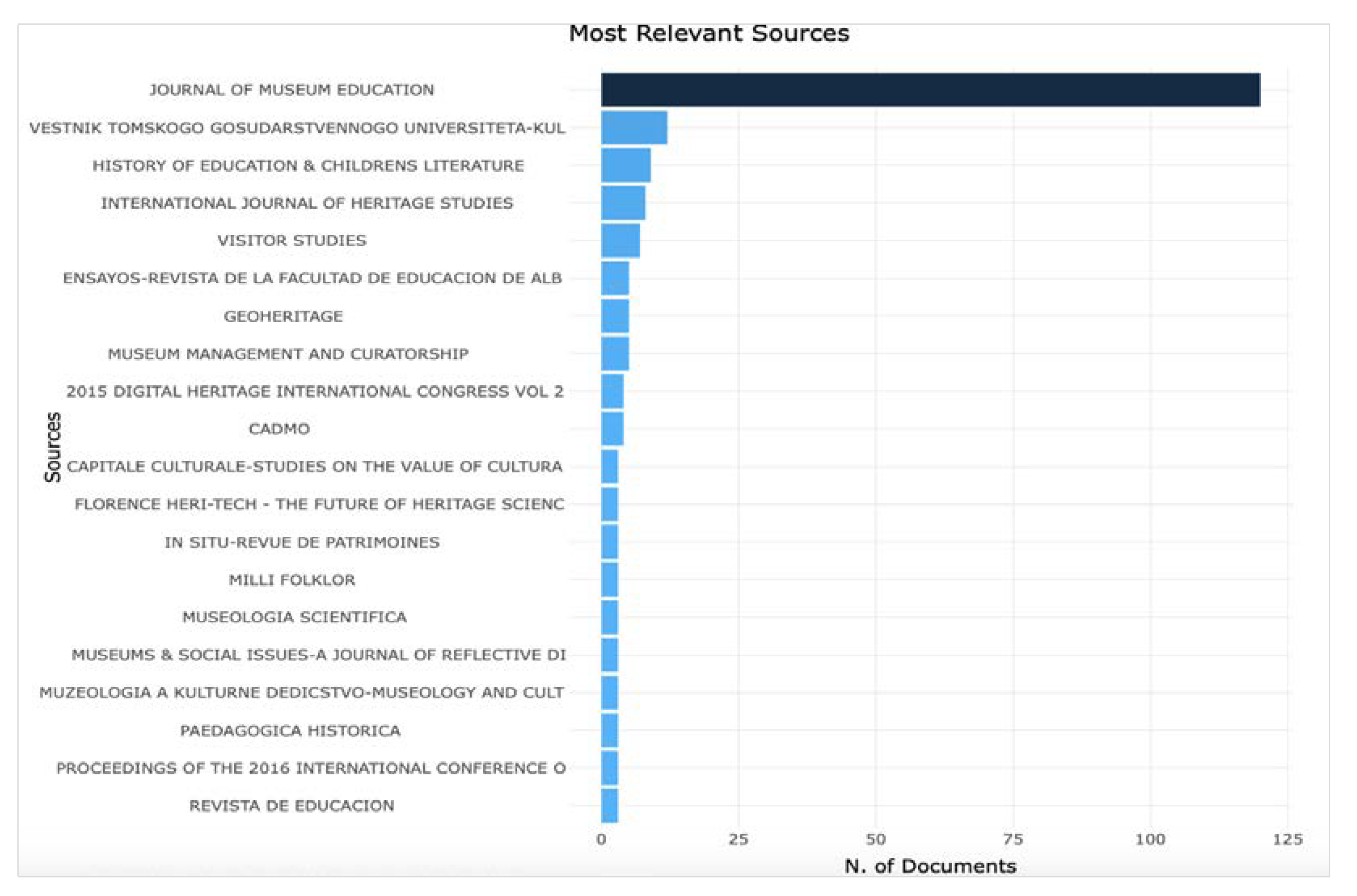
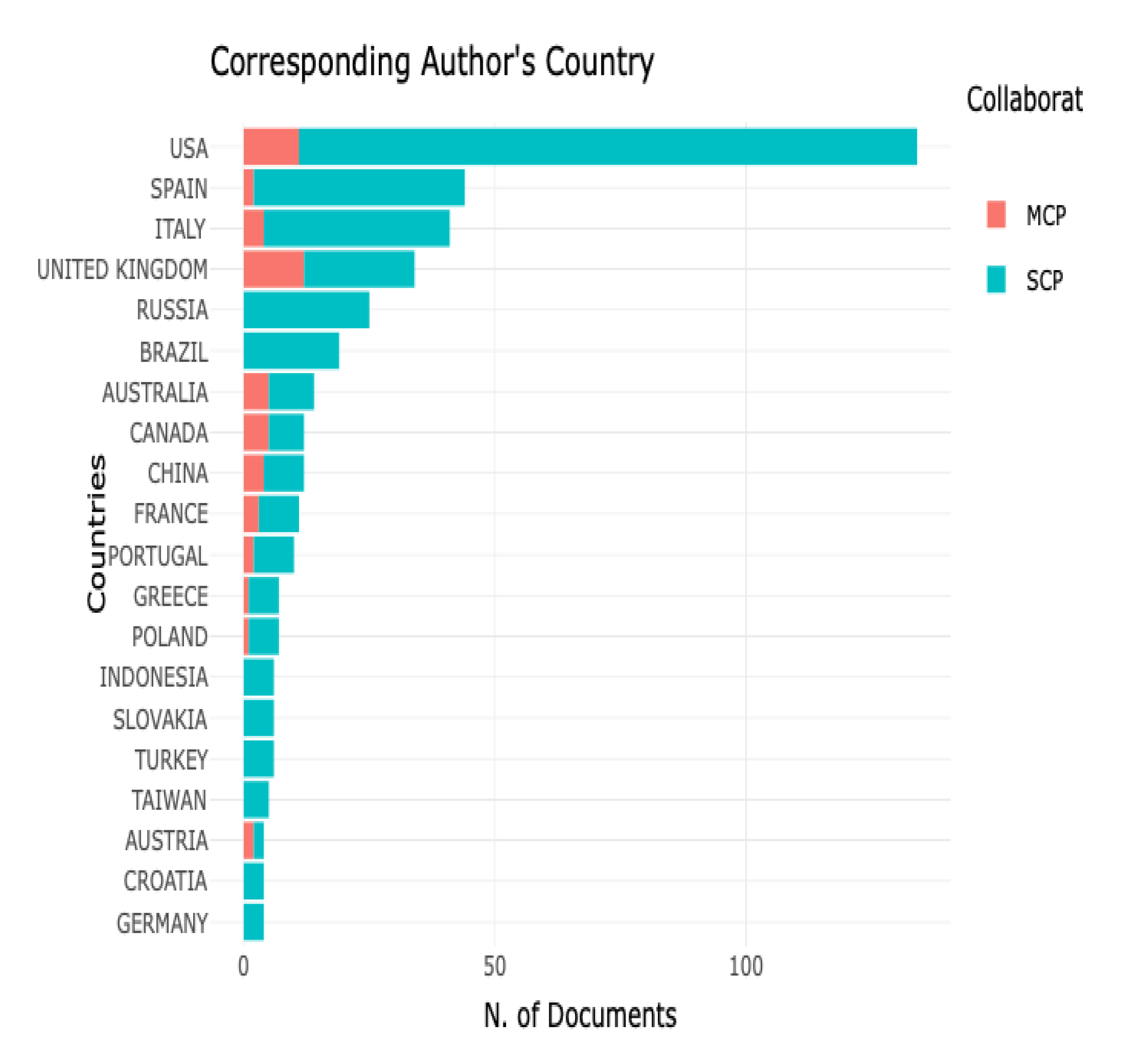


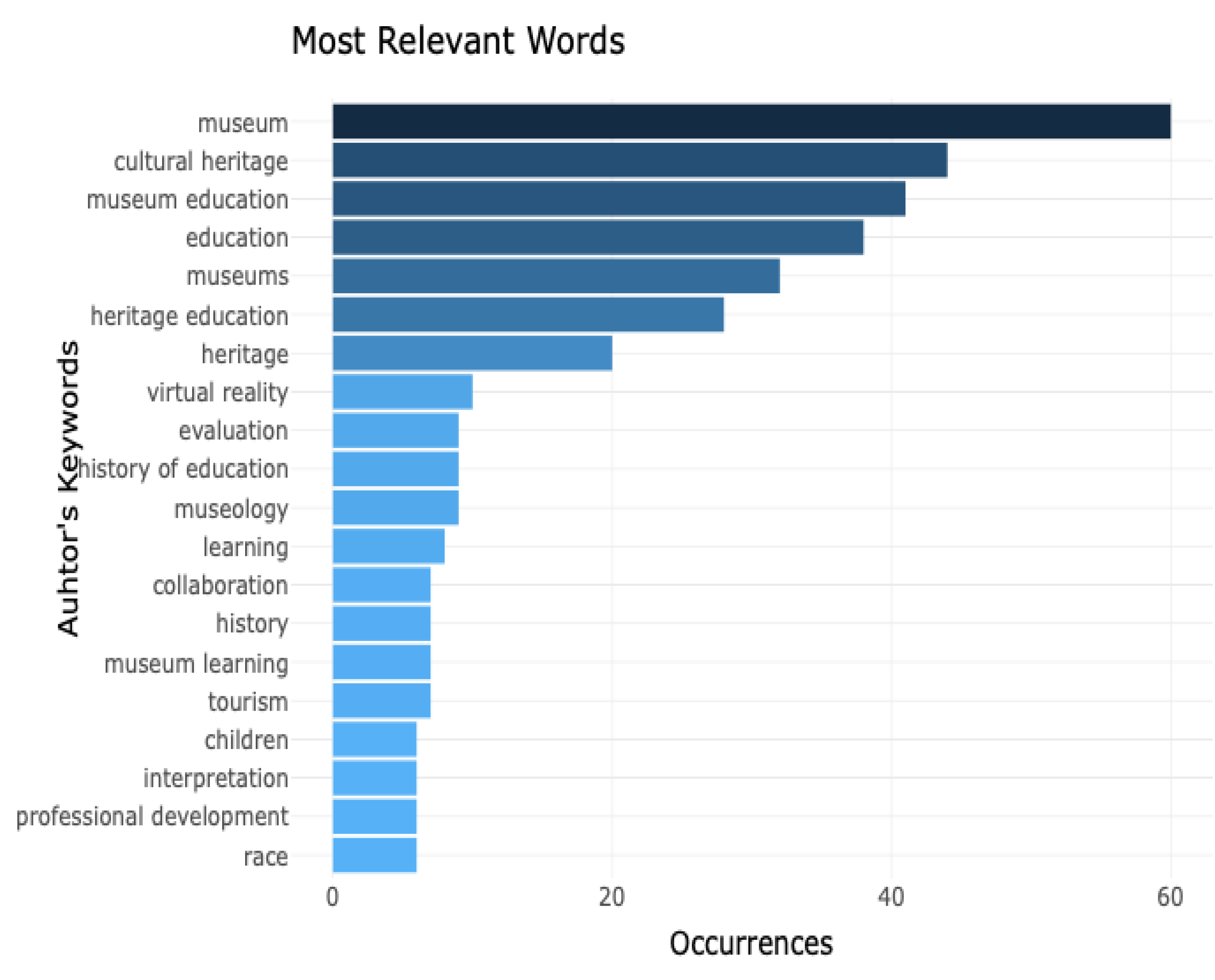


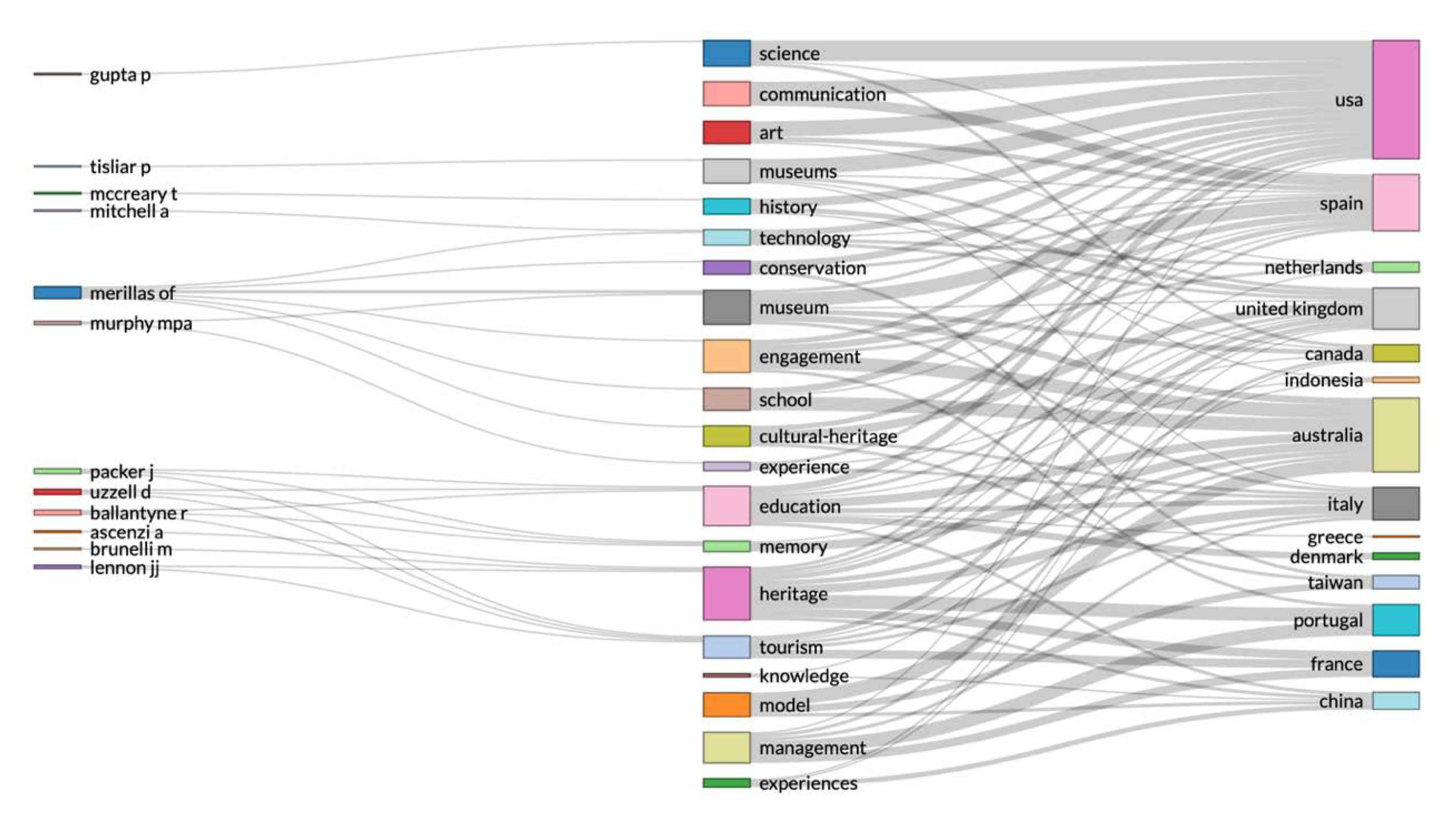

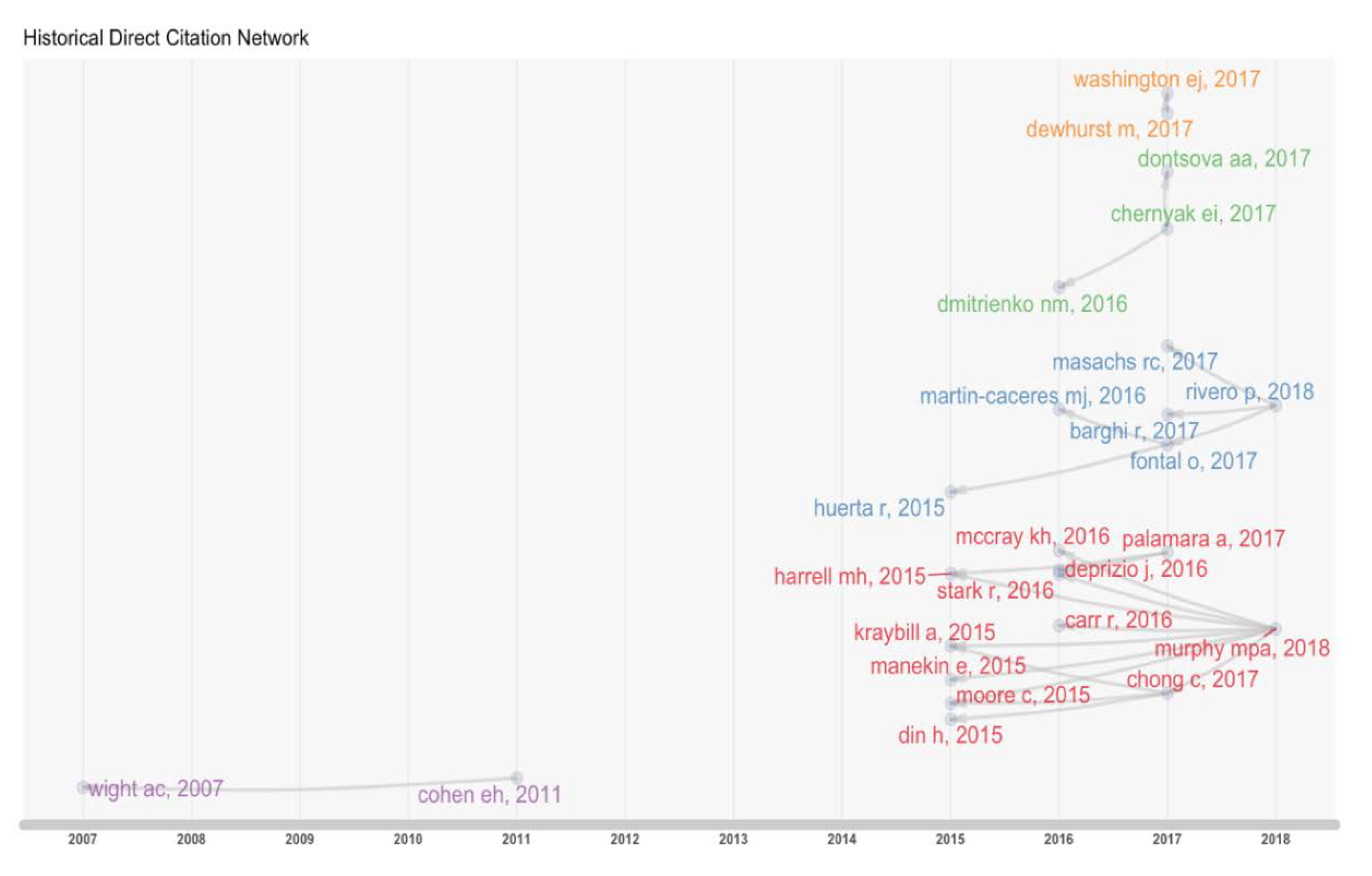

Publisher’s Note: MDPI stays neutral with regard to jurisdictional claims in published maps and institutional affiliations. |
© 2021 by the authors. Licensee MDPI, Basel, Switzerland. This article is an open access article distributed under the terms and conditions of the Creative Commons Attribution (CC BY) license (https://creativecommons.org/licenses/by/4.0/).
Share and Cite
Monteagudo-Fernández, J.; Gómez-Carrasco, C.J.; Chaparro-Sainz, Á. Heritage Education and Research in Museums. Conceptual, Intellectual and Social Structure within a Knowledge Domain (2000–2019). Sustainability 2021, 13, 6667. https://doi.org/10.3390/su13126667
Monteagudo-Fernández J, Gómez-Carrasco CJ, Chaparro-Sainz Á. Heritage Education and Research in Museums. Conceptual, Intellectual and Social Structure within a Knowledge Domain (2000–2019). Sustainability. 2021; 13(12):6667. https://doi.org/10.3390/su13126667
Chicago/Turabian StyleMonteagudo-Fernández, José, Cosme J. Gómez-Carrasco, and Álvaro Chaparro-Sainz. 2021. "Heritage Education and Research in Museums. Conceptual, Intellectual and Social Structure within a Knowledge Domain (2000–2019)" Sustainability 13, no. 12: 6667. https://doi.org/10.3390/su13126667
APA StyleMonteagudo-Fernández, J., Gómez-Carrasco, C. J., & Chaparro-Sainz, Á. (2021). Heritage Education and Research in Museums. Conceptual, Intellectual and Social Structure within a Knowledge Domain (2000–2019). Sustainability, 13(12), 6667. https://doi.org/10.3390/su13126667





